Trees of the year 2025
Text Richard Boon Photographs Richard Boon or as credited
There are four Trees of the Year for 2025 in three categories, namely:
- Common trees: White-milkwood (Sideroxylon inerme subsp. inerme) and Coastal Red-milkwood (Mimusops afra),
- Tree for promotion: Tamboti (Spirostachys africana),
- and Tree for appreciation: Widdringtonia wallichii Clanwilliam Cedar.
The first three species are common in their preferred habitats in KwaZulu-Natal (KZN) and all occur naturally in the eThekwini Municipal Area. The White-milkwood and Tamboti are also found in the Krantzkloof Nature Reserve. The Clanwilliam Cedar is a Critically Endangered species endemic to the Cederberg Mountains. It was formerly heavily harvested for timber. Nowadays, even though fire-adapted and protected, it is threatened by unsuitable fire regimes. I will only cover the species we find around Durban.
Mimusops afra and Sideroxylon inerme subsp. inerme are protected trees in terms of the National Forests Act (1998). It is an offence to cut, damage, destroy, collect, trade, transport or sell them except under licence or exemption from the relevant national government minister.
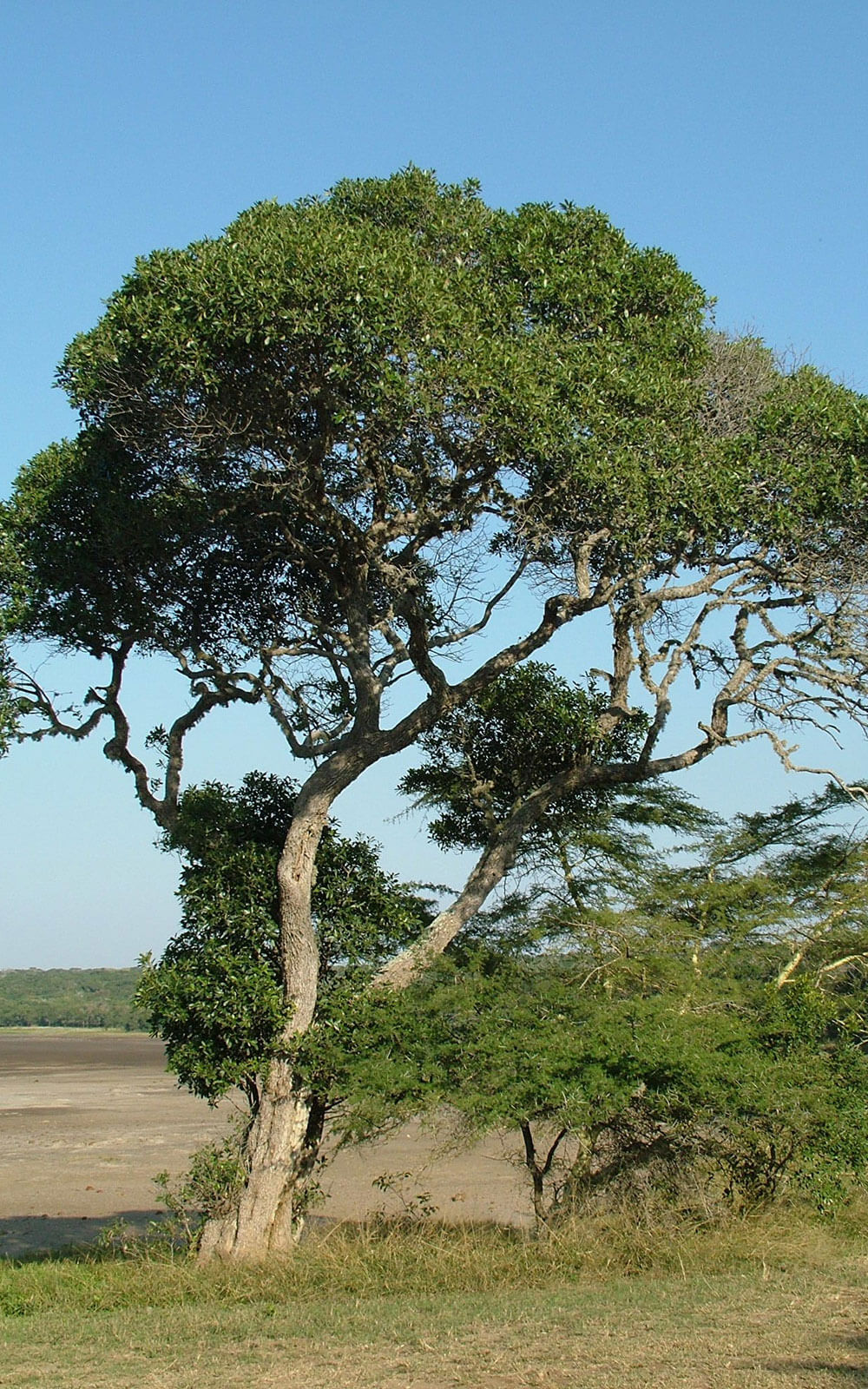
Growing on a small promontory at False Bay Park, this rugged White-milkwood is exposed to strong winds from all directions.
Although they all weep milky sap or latex from broken parts, the Tamboti is in the euphorbia or spurge family (Euphorbiaceae) and the milkwoods are in the milkwood or sapodilla family (Sapotaceae).
The euphorbia family is the fifth largest plant family with about 7 500 species in 300 genera. It incorporates a wide range of growth forms including annuals and perennials, small herbs, shrubs, stem succulents like the iconic Naboom, and plants like the Tamboti that look much like any other tree. While the divergent growth forms suggest they are unrelated, all produce three-lobed capsules which split when mature to release their seeds. Some parts of the euphorbia family have relatively recently been removed to form new plant families.
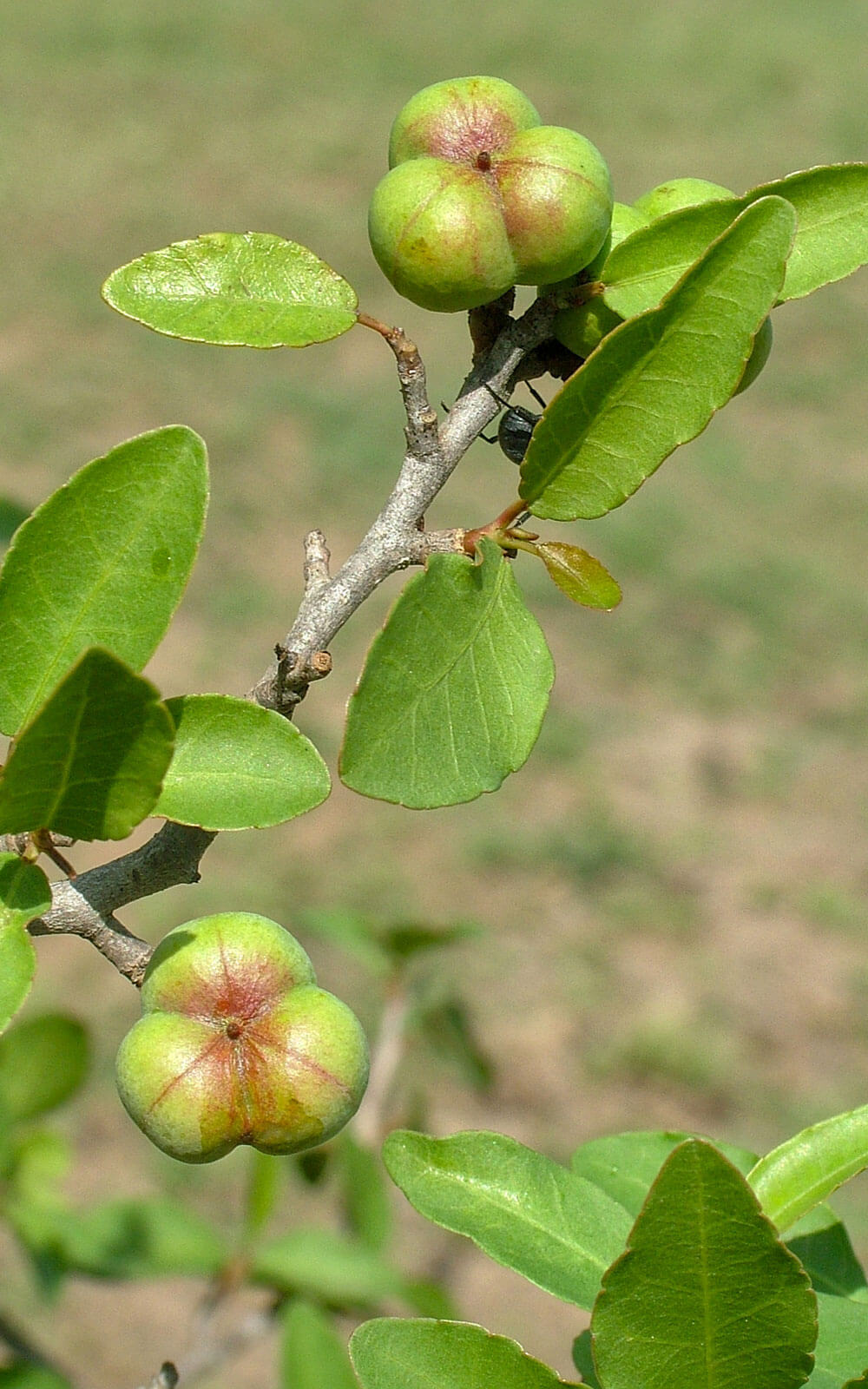
Plants in the euphorbia family have three-lobed capsules like this Tamboti at Hluhluwe-Imfolozi Park.
There are 24 native tree species in the milkwood family in South Africa. The family Sapotaceae takes its name from the Central American Manilkara zapota, which is commonly known as sapote or sapodilla and is grown for its edible fruits. Shea butter used in cosmetics comes from a tree in the family. Some members of the milkwood family superficially resemble fig plants and the milky sap enhances the resemblance, but milkwoods and figs are unrelated. Fig ‘fruits’ are specialised structures that bear the tiny fruits inside a receptacle. Milkwoods have more typical fleshy fruits (berries), often with a persistent wispy style at the end. Figs have entire, serrated or lobed leaves, while milkwood leaves are always entire, i.e. the leaf margins are smooth. When the specialised structures (stipules) which protect the growing points on fig branchlets fall, they leave a characteristic scar that encircles the stem. Such scars are absent in milkwoods. The new growth on milkwoods is often brownish- or rusty-coloured. The characteristic fissured, blocky bark is a good way of recognising some members of the family in tall forest.
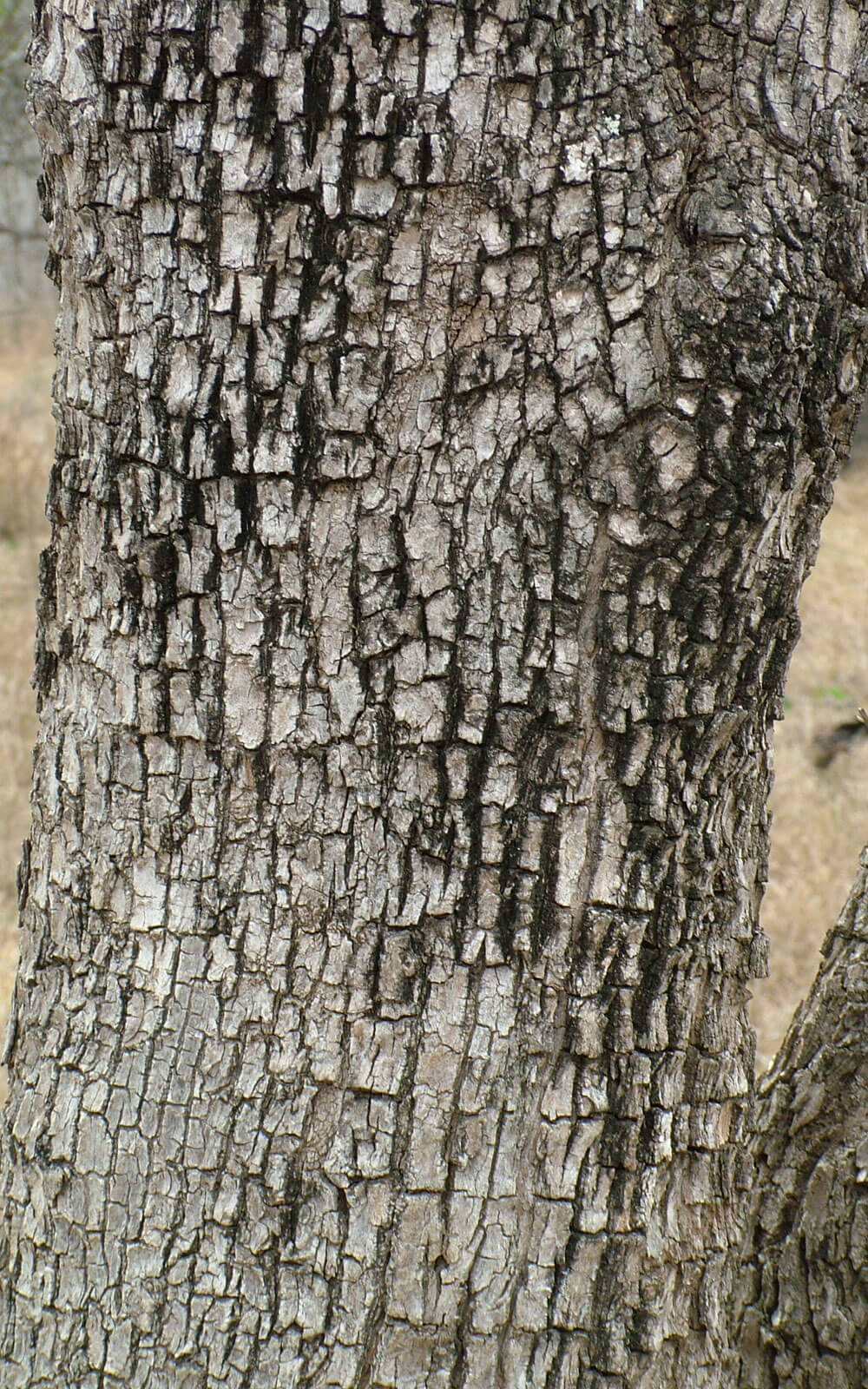
Many members of the milkwood family have ‘blocky’ bark as in this White-milkwood at Mkuze Game Reserve.
Coastal Red-milkwood Mimusops afra
Until recently the Coastal Red-milkwood’s scientific name was Mimusops caffra. The derivation of Mimusops is obscure. In July 2024, at the International Botanical Congress in Madrid, Spain, 63% of the botanists attending voted (60% were required) to change the names of over 300 plant, fungi and algae species with the specific epithet caffra to afra (or similar). Afra refers to their African origins. The proposal came from Professors Gideon Smith and Estrela Figueiredo of Nelson Mandela University and aimed to eliminate the association with a racially offensive word used against black people in several languages. This move will increase the pressure for broader changes where, for example, people as infamous as Adolf Hitler and Benito Mussolini, have been commemorated in scientific or common names of plants and other organisms. Other eponymous names are less obvious but are still offensive. For example, in Australia, a well known genus Hibbertia is named after George Hibbert, who became wealthy through slave trading. Botanists have now established a committee to try and eliminate all derogatory terms when new species are named in the future. So far the world’s zoologists have declined to follow the lead of their botanical colleagues.
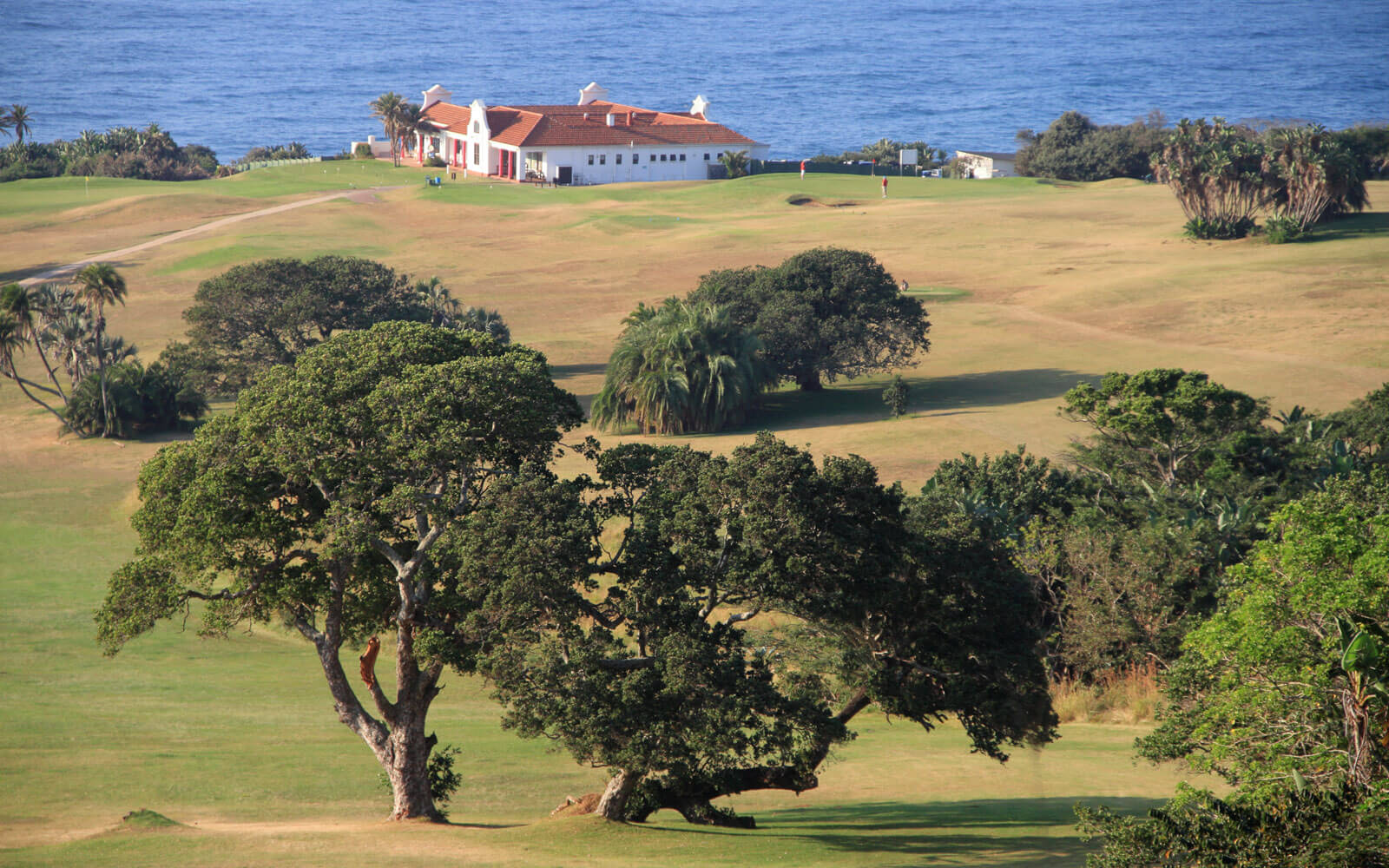
Coastal Red-milkwood at Umdoni Park, Pennington. This tree (or trees) was almost certainly growing in the coastal dune forest that was cleared, perhaps in the early 1920s, to develop the golf course.
The Coastal Red-milkwood is one of KZN’s iconic trees. Other than in the far northern part of the province, near the Mozambican border, it is strictly confined to dune forest, ranging from about Port Alfred in the Eastern Cape to near Vilanculos in the Inhambane province in southern Mozambique. Where protected from strong wind and salt spray, it is medium to fairly large tree with a spreading crown that produces excellent shade—a feature recognised in one of the Zulu names umthunzi, which means shade. Specimens are shorter and stunted on coastal foredunes because strong winds and salt are natural pruning shears. The thickly leathery leaves are greyish green above and dirty white to reddish brown below due to a dense covering of short hairs. In spring and summer (less often at other times of the year) it has attractive white, nodding, star-shaped flowers, similar to other members of the genus. The oval fruits are orange-red, have a wispy persistent calyx at the tip and are present most of the year. They are sweet, tasty and edible and are loved by monkeys and birds. The tree is the larval food plant of the butterfly Pseudacraea lucretia or False Chief, which is a species that mimics the distasteful Chief and Layman butterflies.
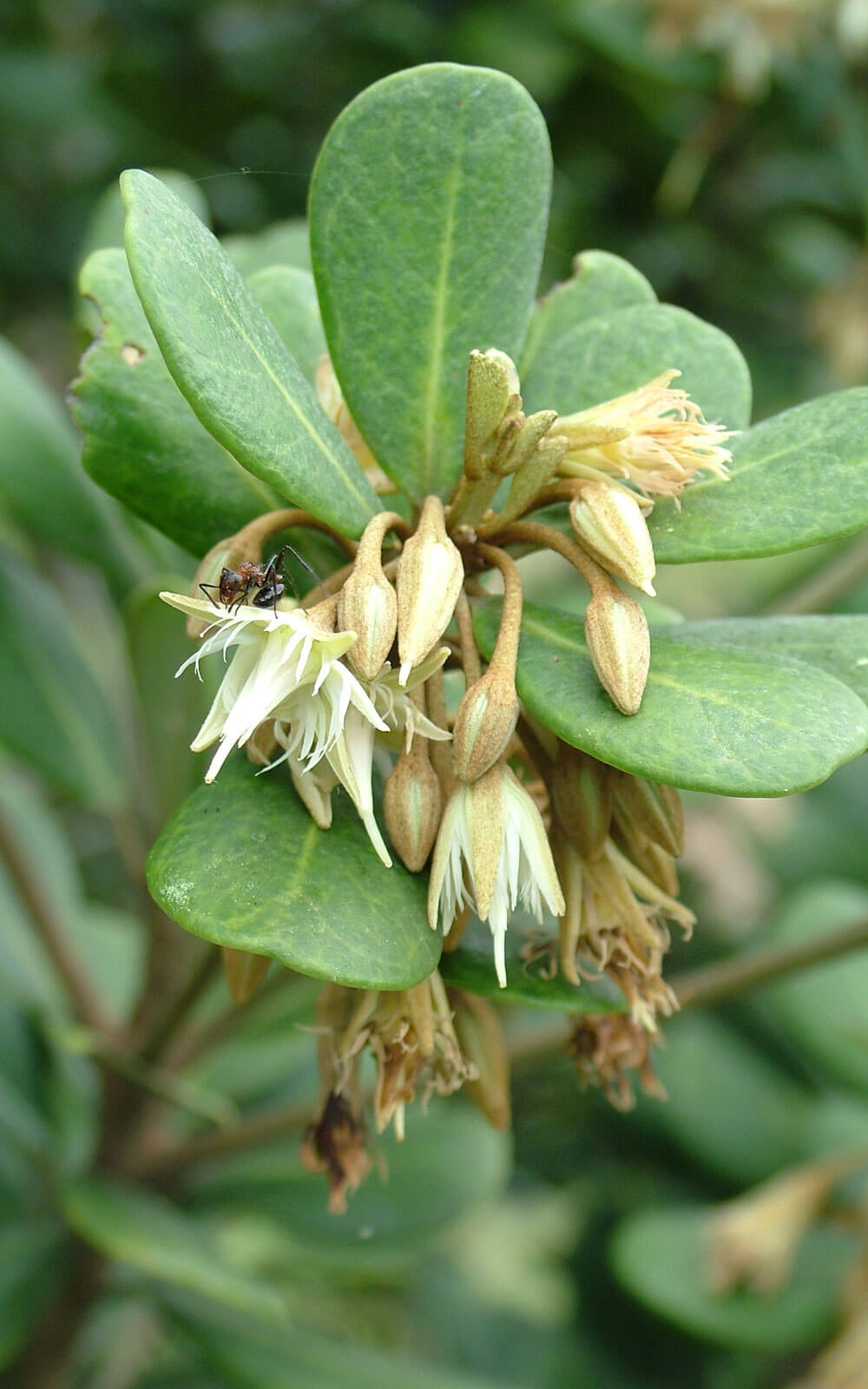
Thick leaves with rounded tips and nodding, star-shaped, white flowers, and their fidelity to coastal areas, makes it easy to recognise Coastal Red-milkwoods.
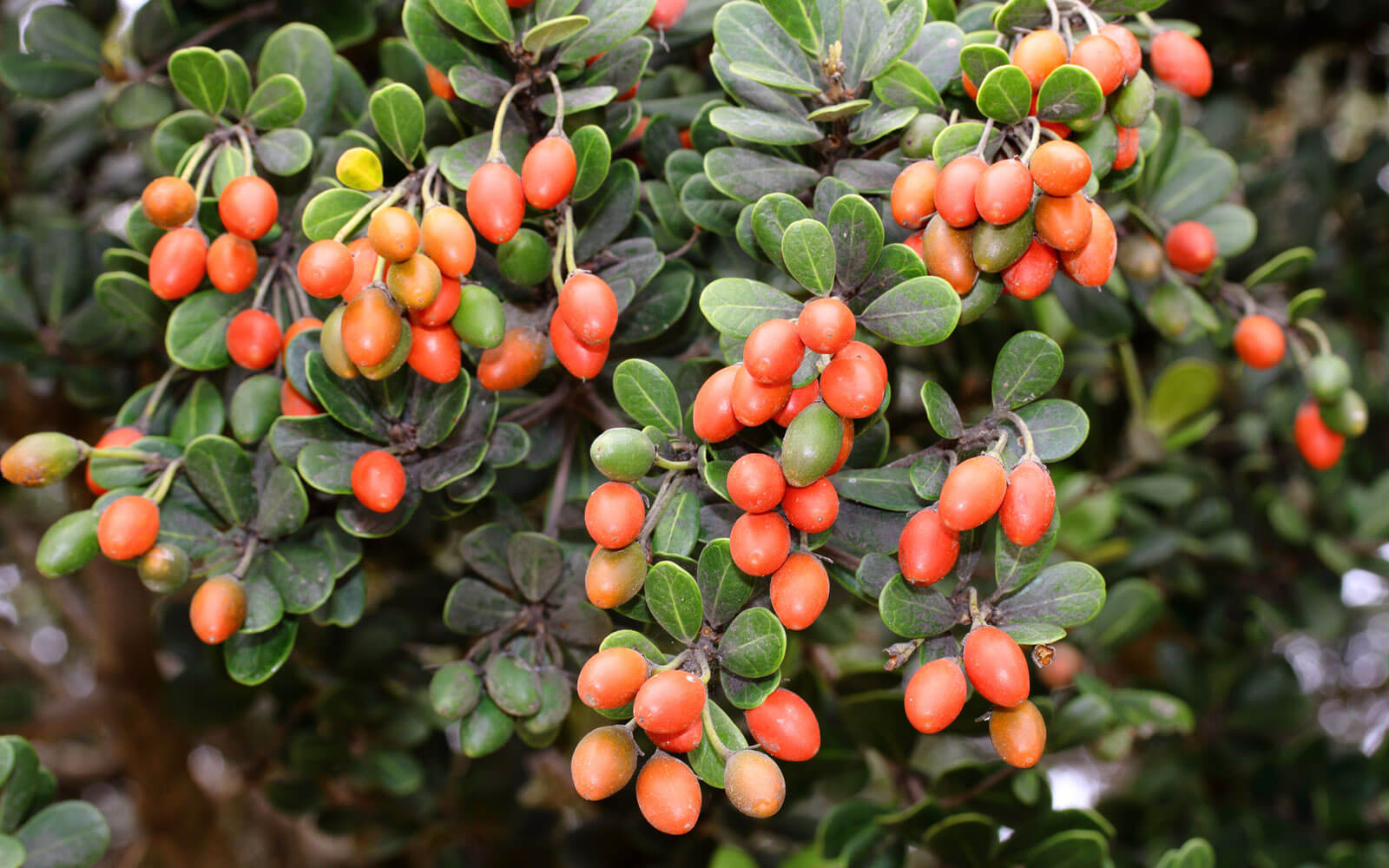
A heavy crop of fruit on a Coastal Red-milkwood at Gonubie in the Eastern Cape.
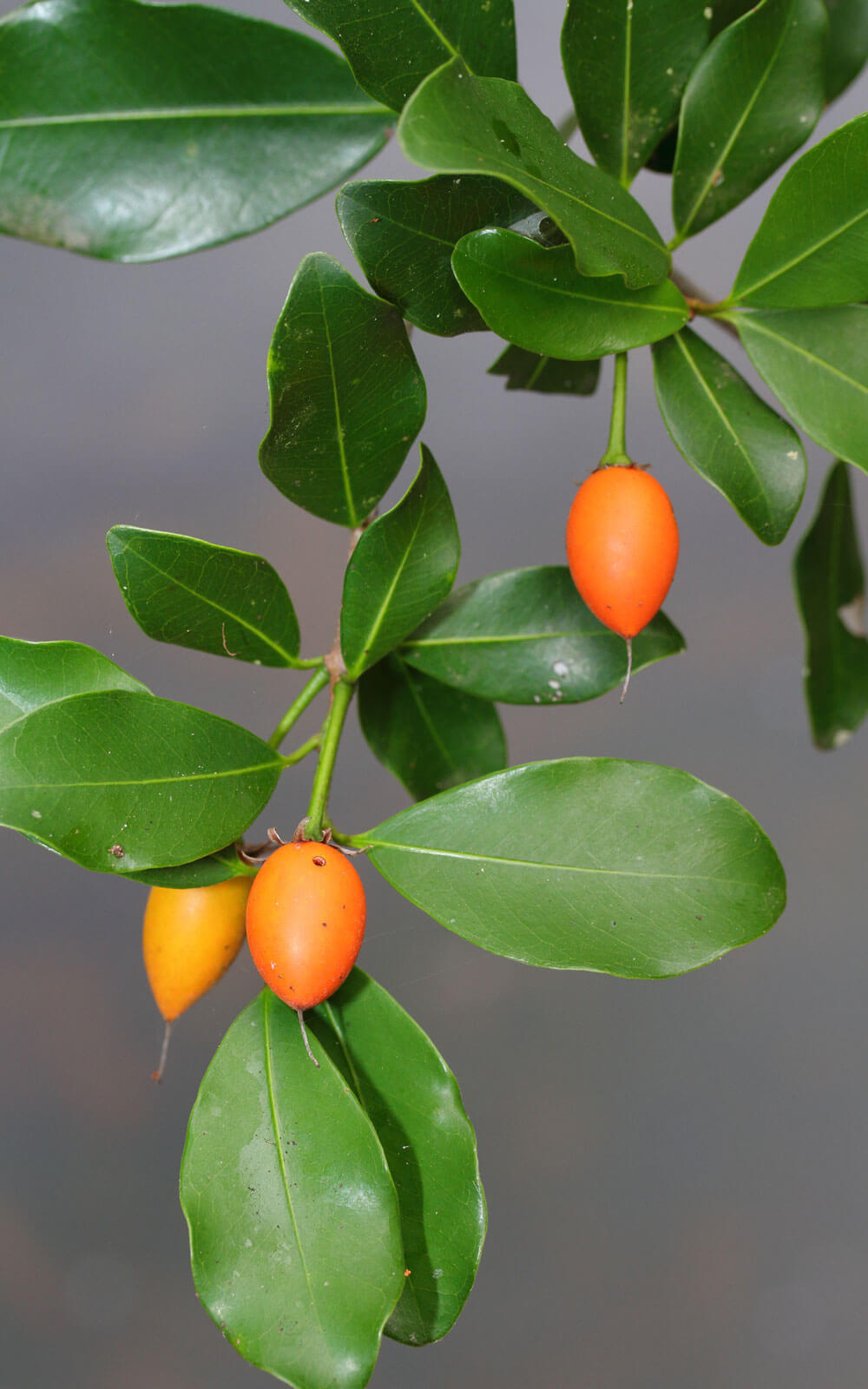
The Forest Red-milkwood is a better option than the Coastal Red-milkwood for Upper Highway gardens. This plant was growing at the Empisini Nature Reserve, Umkomaas. Note the persistent wispy style on the tip of the fruit.
If you live in the Upper Highway Area and want to grow a red-milkwood, then the Forest Red-milkwood Mimusops obovata is a better option. It grows naturally in local forests and moist bushveld. Forest Red-milkwoods can be large, but are usually smaller than Coastal Red-milkwoods. The flowers and fruit are similar to M. afra, but the fruit is less plump. Flowers are visited by bees, carpenter bees and sunbirds. The leaves are green below, less leathery and more or less hairless when mature. This species is also a larval food plant for the False Chief, but in addition it hosts Pseudacraea boisduvalii trimenii or Boisduval’s False Acraea and P. erytus imitator or False Wanderer butterflies. These mimics avoid predation by successfully mimicking toxic or distasteful butterflies.
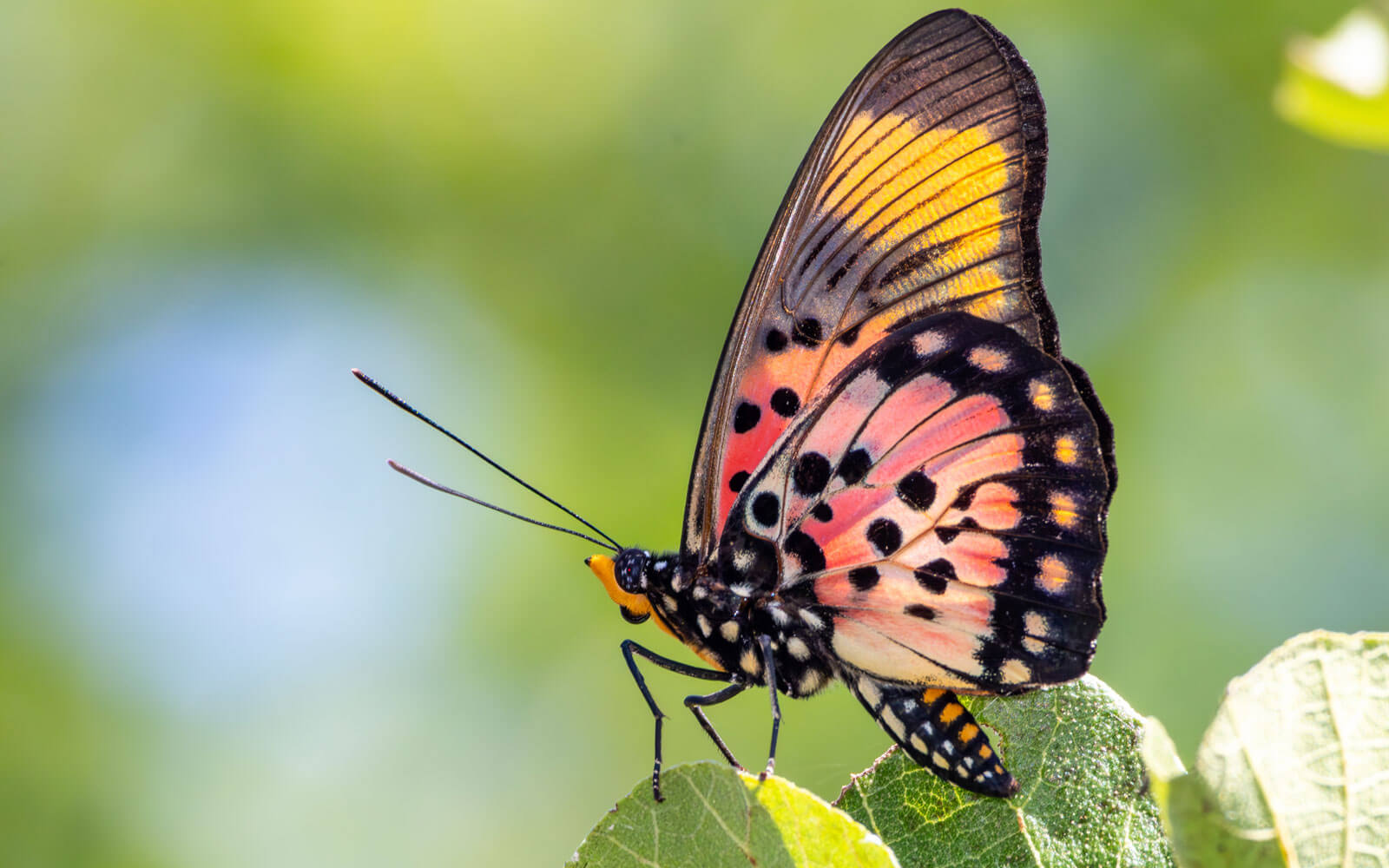
A male Boisduval’s False Acraea at the Krantzkloof Nature Reserve. These conspicuous butterflies avoid predation by mimicking distasteful butterflies. Butterflies are highly reliant on host plants to breed and this one would probably have hatched from an egg laid on a Forest Red-milkwood.
Photo: Steve Woodhall
In autumn, substantial patches of leaves in the crown of Forest Red-milkwoods may be covered in webs produced by caterpillars of the web-spinning moth Bostra carnicolor. Then the trees can be easily spotted in the forest canopy. The caterpillars are less commonly found on Coastal Red-milkwoods. Fortunately, they seem to have little impact on the trees.
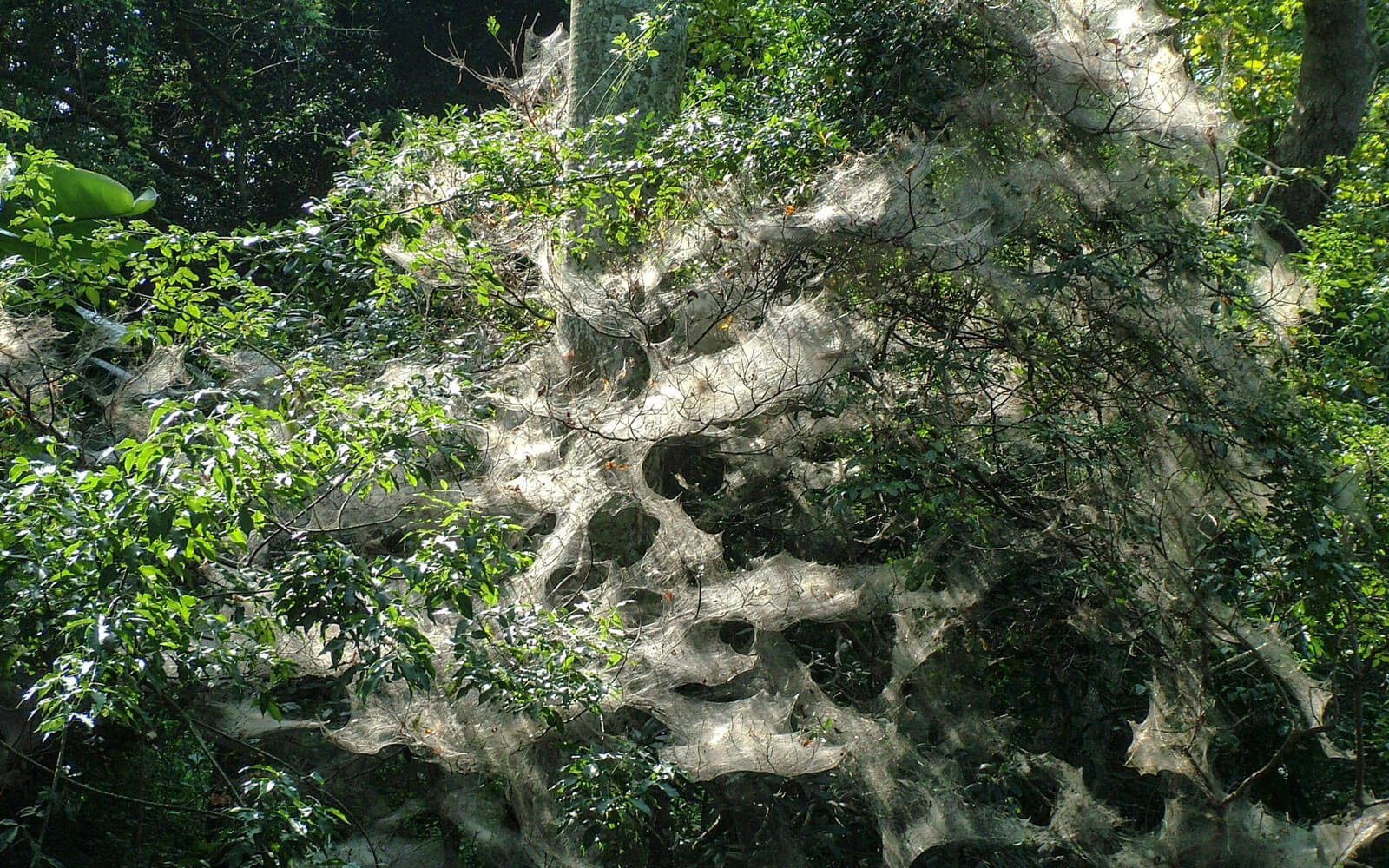
Webs of the moth Bostra carnicolor on a Forest Red-milkwood at Pigeon Valley Nature Reserve, Durban.
Both species of red-milkwood have reddish-brown heartwood and pink to reddish sapwood. The wood is hard and some of the uses include making furniture, huts, knobkieries and fish traps. The wood is considered royal wood by Zulus. The plants are used medicinally. They can be grown from cleaned seed or cuttings.
White-milkwood Sideroxylon inerme subsp. inerme
The White-milkwood’s scientific name is Sideroxylon inerme subsp. inerme. The genus Sideroxylon includes 83 species, which are found in Africa, the Americas and Asia. The White-milkwood is the only species found in southern Africa. Sideroxylon means ‘iron wood’ and refers to the tree’s pale (white to yellow), hard, heavy heartwood and inerme means ‘unarmed’ or without thorns or spines. When Linnaeus named the genus in 1753, he included two species, i.e. S. inerme and S. spinosum, a spiny species from north-west Africa. The other subspecies of S. inerme are found from Mozambique to Somalia and on Seychelle’s Aldabra Islands.
Sideroxylon inerme has at least two Zulu names. One is amasethole-amhlophe, which means ‘the white maas of the heifer’ and presumably refers to the white milky sap. The other is umakhwela-fingqane, which means ‘the one that grows in a twisted, contorted, winding manner’. This is apt because trees often have gnarled trunks.
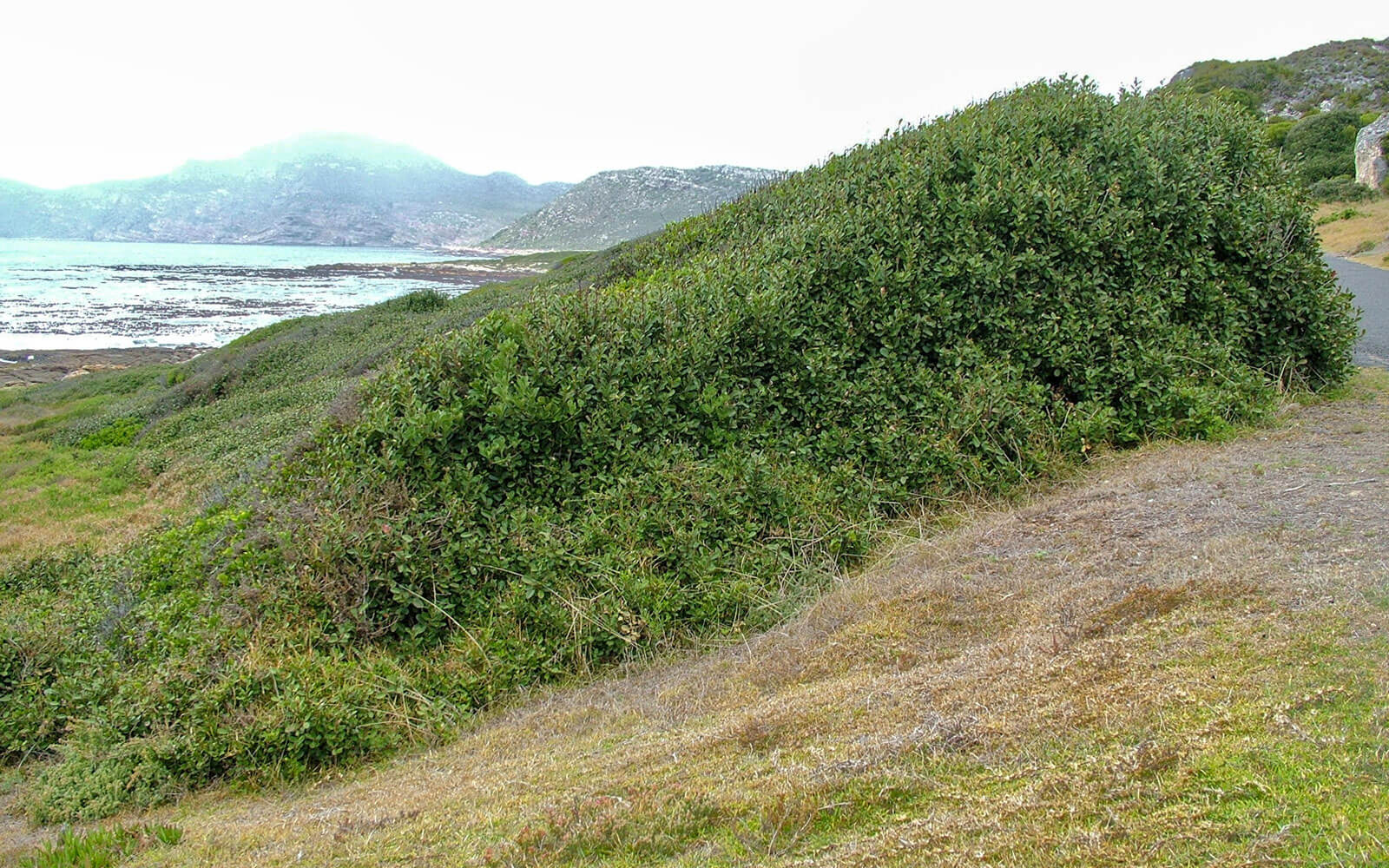
White-milkwood ‘hedged’ by strong, salt laden, coastal winds at Cape Point Nature Reserve, Cape Town.
The White-milkwood is a small to medium-sized tree which grows in dune scrub and forest, coastal forest and inland in bushveld, where it is often associated with termitaria. It has a wide distribution and occurs from the Cape Peninsula to East Africa. The bark has the typical rectangular blocks, which are common to many species in the family. Like all members of the family, the leaves are held in an alternate, spiralled arrangement along the stems. They are dark green, leathery and smooth with a pale midrib. When they are young, they have a coating of fine reddish hairs below. Old leaves turn orange-red. The small greenish white or cream flowers are unpleasantly scented and held in tight clusters in the leaf axils, or sometimes on bare stems if the leaves have fallen. Flowers can be present from spring to autumn and the round, glossy, purple to black berries follow in autumn to winter. The fruit is popular with various animals and birds. The wood is heavy (>1 000 kg/m3) very hard, fine-grained and durable. Parts of the tree are used in traditional medicine.
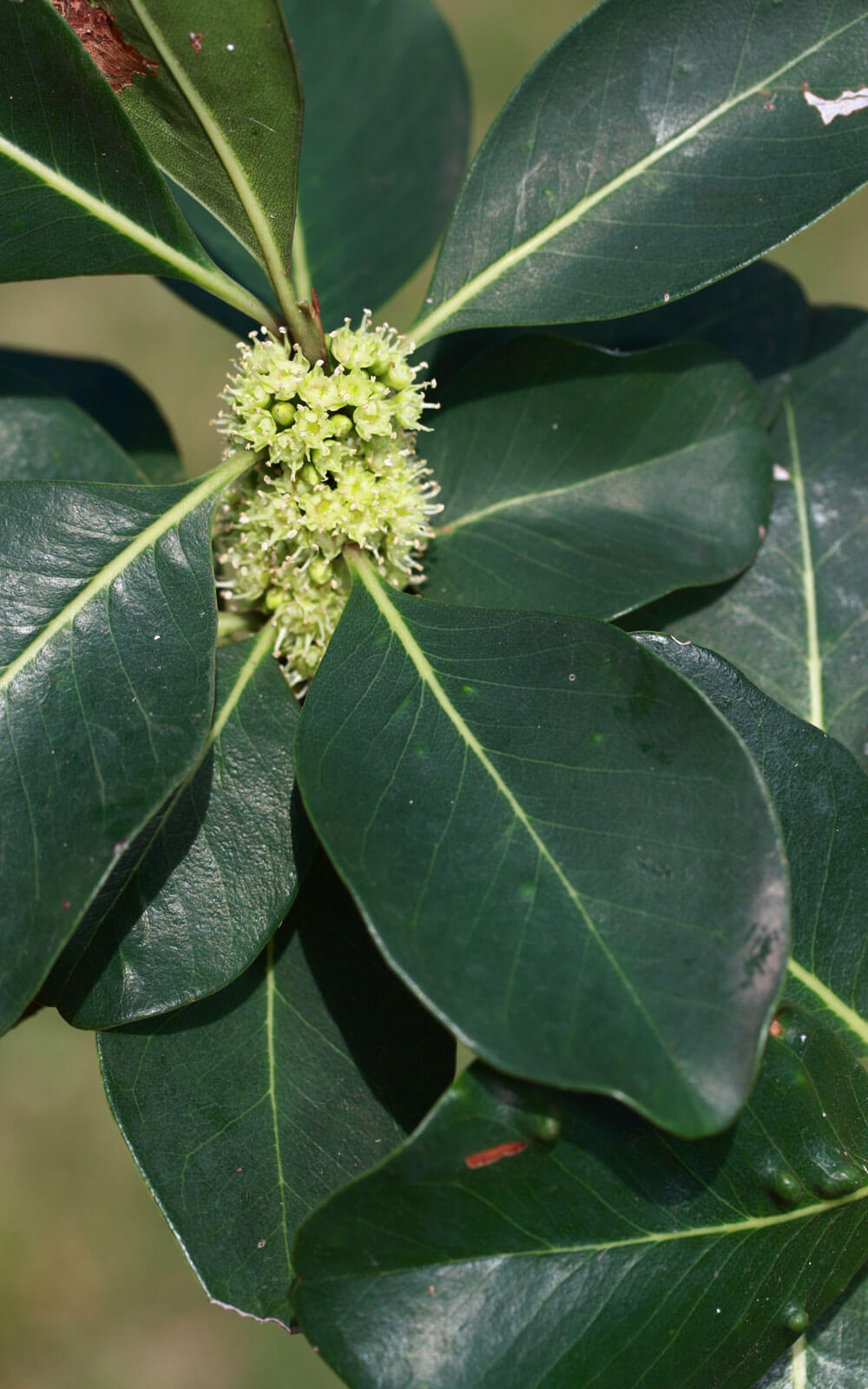
The flowers of White-milkwoods have an unpleasant smell and are held in tight clusters toward the end of the branchlets. The prominent pale main vein is a good identification feature.
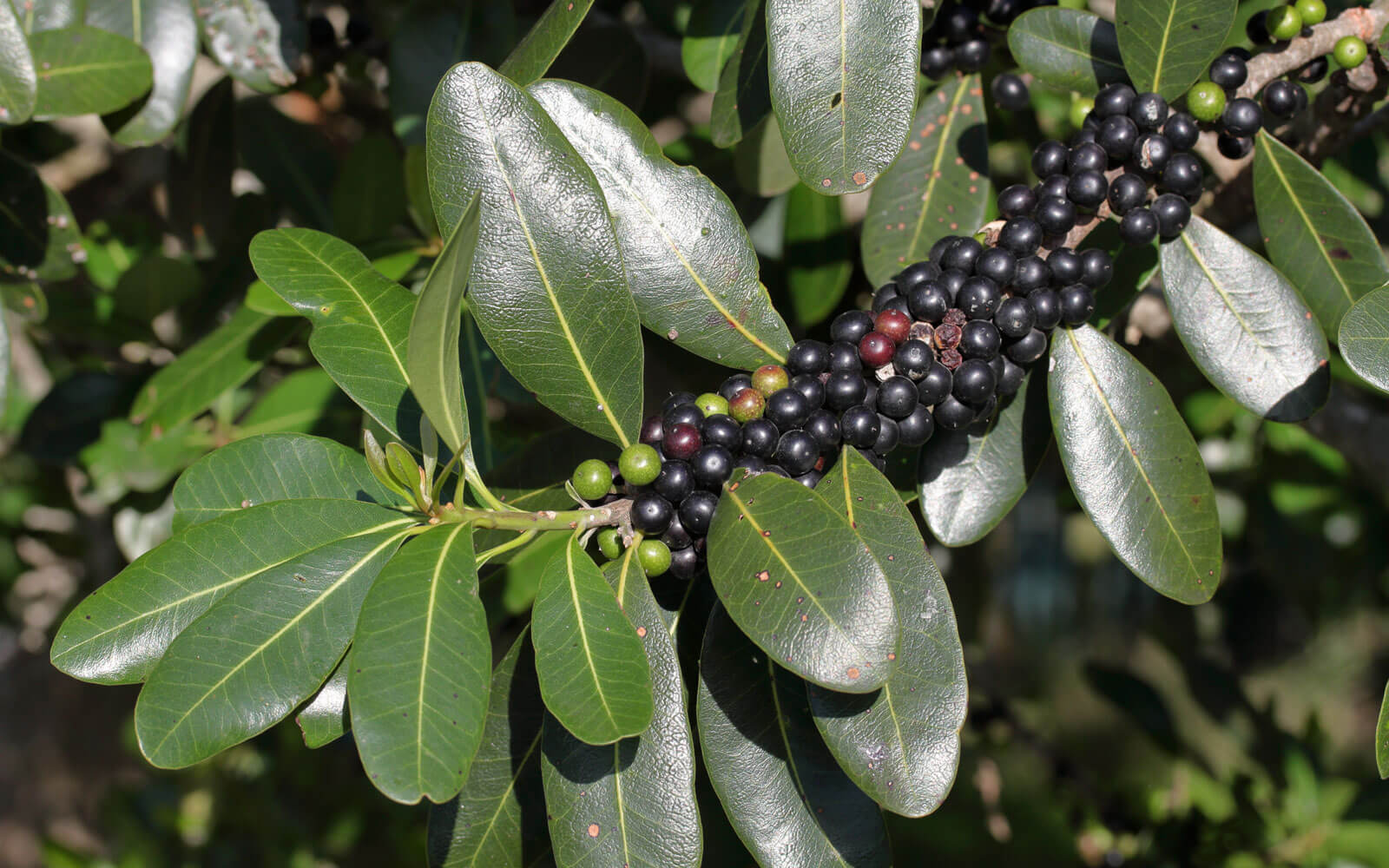
The pollinated flowers develop into tight clusters of purple-black fruits.
Plants are best grown from cleaned seed. The White-milkwood makes a good screen and tolerates wind, which makes it a useful plant for coastal gardens. It can be pruned to shape.
Several White-milkwoods are National Monuments. The Treaty Tree in Woodstock, Cape Town is estimated to be over 500 years old. It stands where peace was made between the British and the Batavian Government (Dutch) on 10 January 1806 at the now demolished Treaty House after the battle of Blaauwberg. The Post Office Tree at Mossel Bay is thought to be more than 600 years old. It served as a place for sailors to leave letters from 1500 onwards after a Portuguese sea captain first left a message warning of rough seas and the loss of Barthomoleu Dias and his ship at sea. Remarkably, the message was found the following year by its intended recipient who was an explorer sailing under the Portuguese Flag. The Fingo Milkwood Tree in the Peddie district of the Eastern Cape is protected because it was where the Mfengu people declared loyalty to God and the British King after fleeing to the Cape Colony to avoid persecution by Chief Hintsa of the Gcaleka Xhosa.
Tamboti Spirostachys africana
There are two species of Spirostachys. Ours occurs from the former Transkei in the Eastern Cape to Namibia, Angola, Botswana, Zimbabwe and Kenya and the other is found from Tanzania to Somalia.
The English and Afrikaans common names Tamboti and tambotie are derived from umthombothi in Zulu. Umthombothi is a combination of umthombo ‘spring, fountain’ and umuthi ‘tree’. Tambotis are at home in warm, dry, low-altitude bushveld and are often found in groves, especially along rivers and in other places where soils are poorly drained.
The genus name comes from the Greek ‘speira’ which is a spiral and ‘stachys’ which is a spike; the minute flowers are arranged in a tight spiral on short, brown spikes. There may be one or a few female flowers at the base and many male flowers above. The yellowish flowers, which may be red-tinged, are produced in late winter or early spring, often when the tree is leafless. The female flowers develop into the characteristic three-lobed capsules of the family. The capsules are green at first and split explosively and audibly into three parts once they mature and turn yellowish brown from spring to early summer.
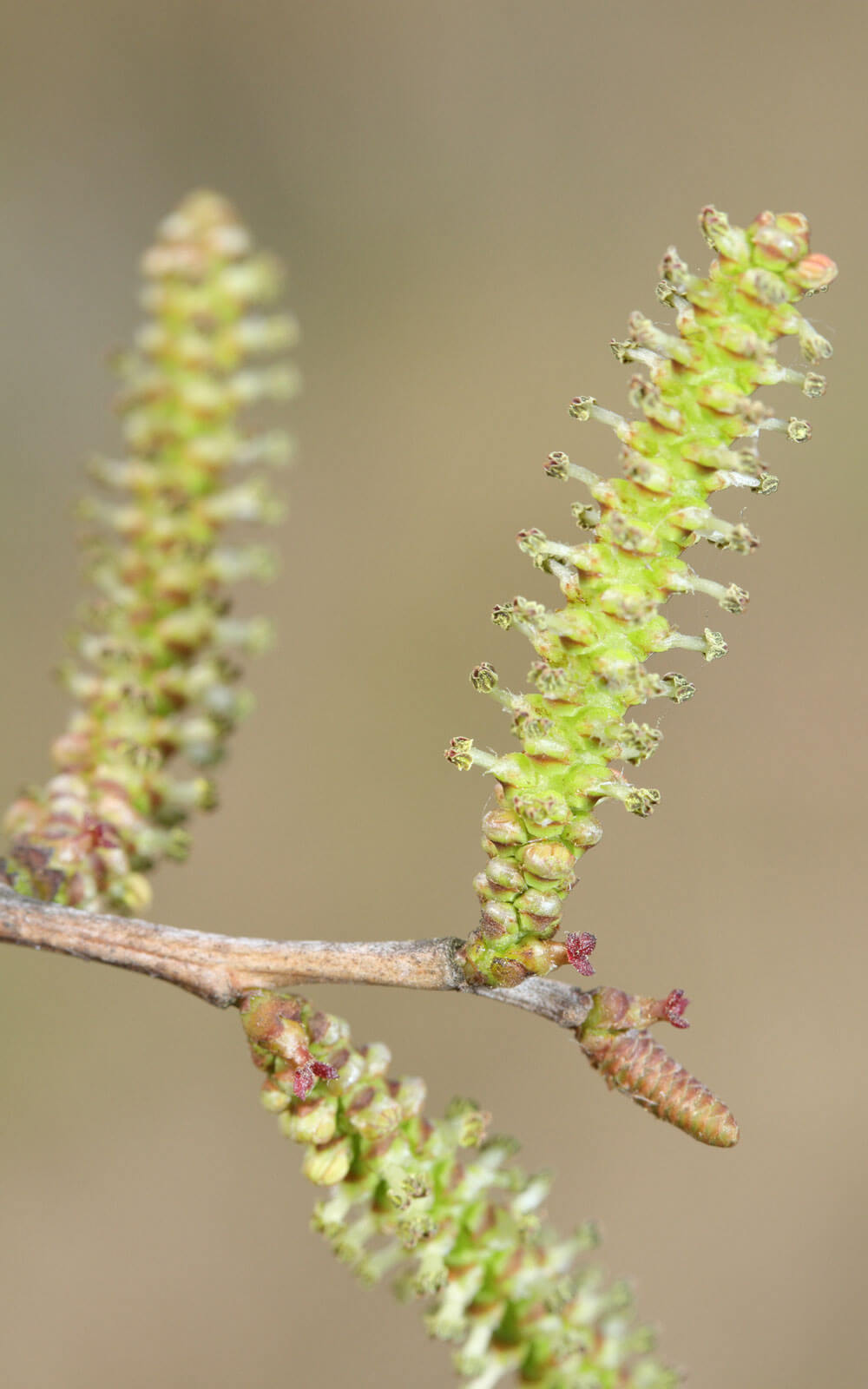
The Tamboti inflorescence is a spike with many male flowers on top and one to several female flowers at the bottom. In this example from the Inanda Valley there is one female flower at the base of each spike.
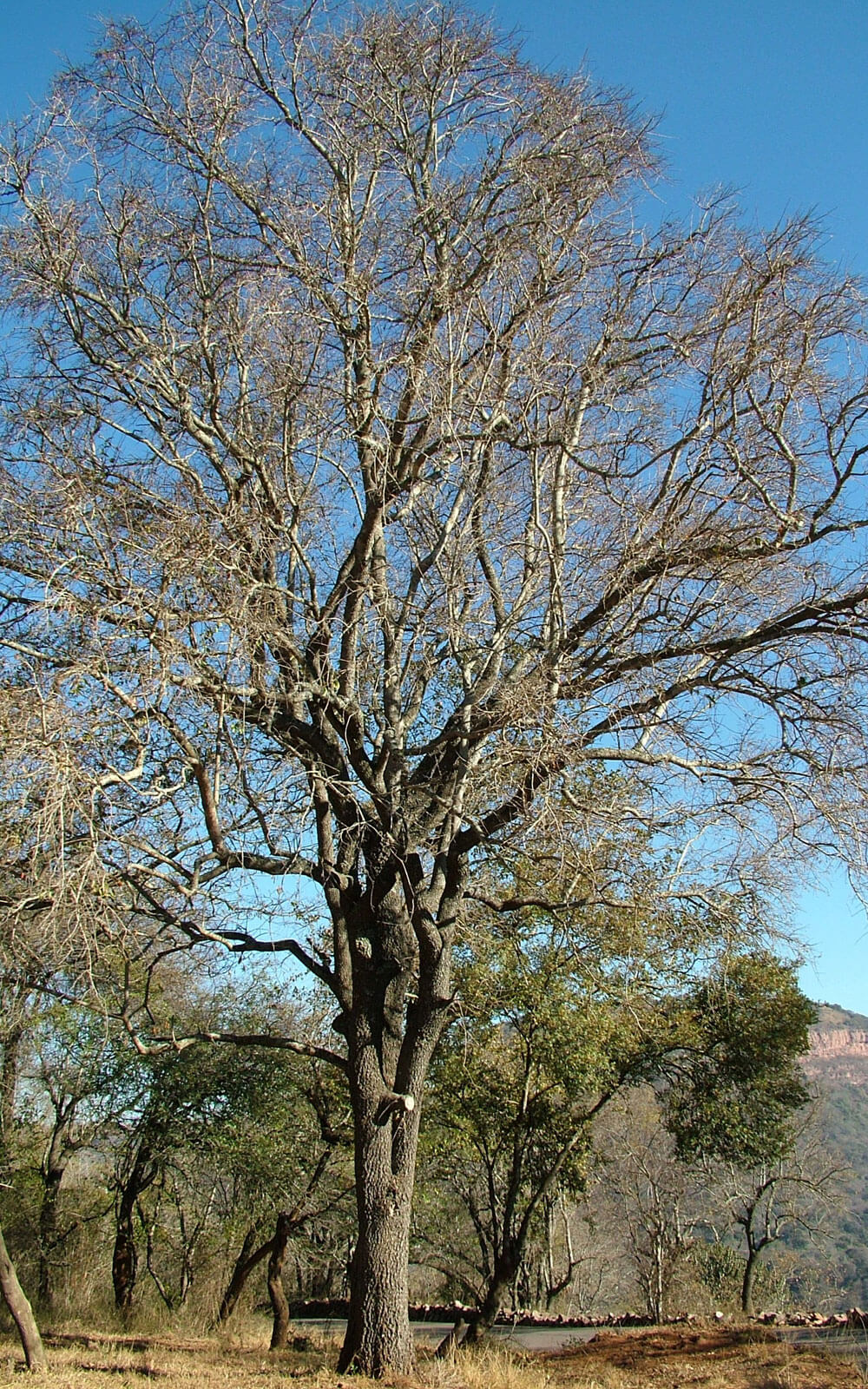
This Tamboti was photographed at Shongweni Dam in July after the leaves have fallen. Where trees grow in groves they tend to be smaller, perhaps at least partly due to competition.
Tambotis are medium-sized, deciduous trees with erect, straight stems and roundish crowns. The bark is smooth and grey when young and becomes dark and rough with distinctive irregular blocks with age. The twigs of young plants may end in spines. Leaves are fairly small and thinly-textured. The margins are usually scalloped. There are two tiny glands at the base of the leaf where the stalk joins the blade. The leaves turn yellow and then a beautiful red before falling in winter.
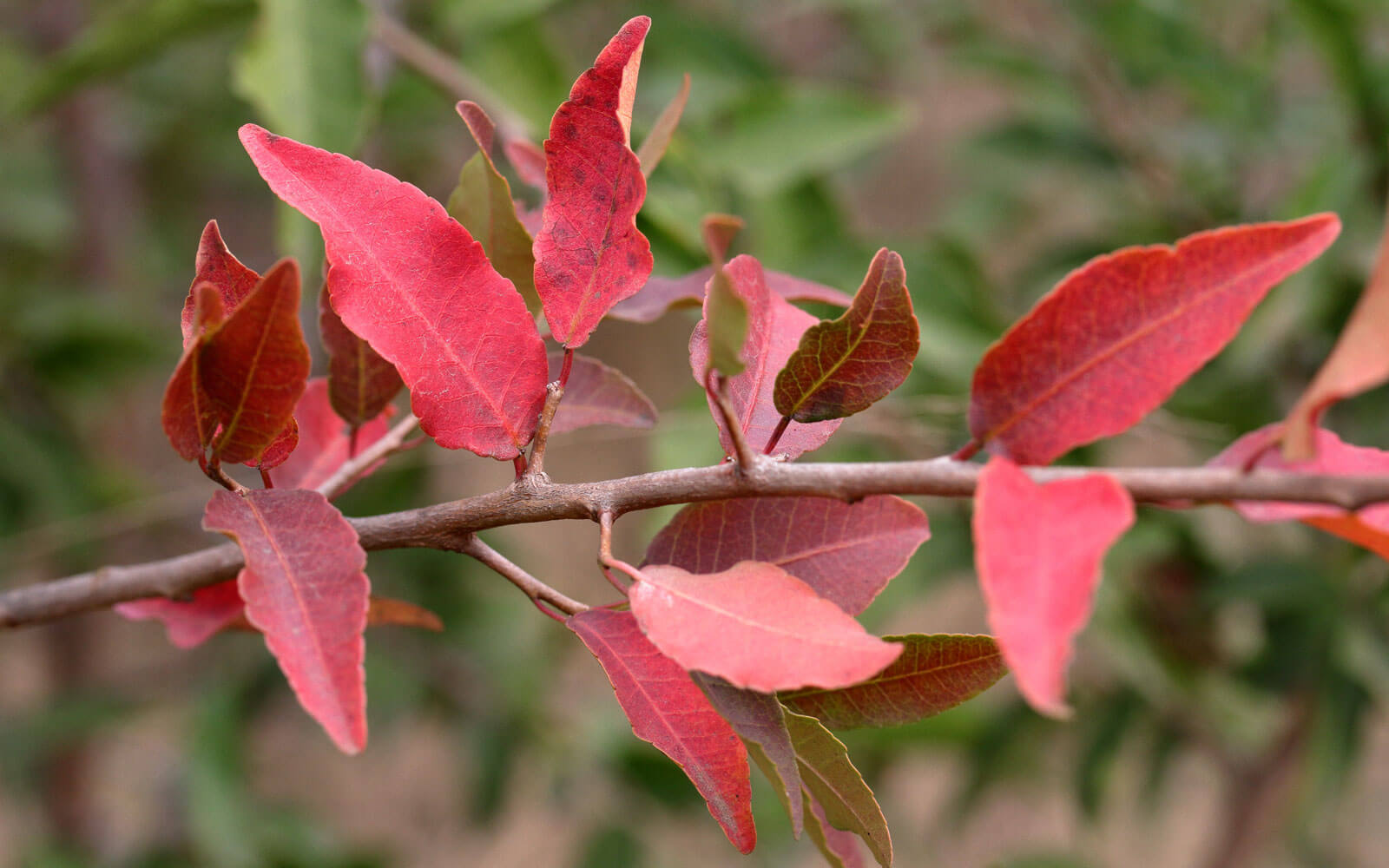
Tamboti leaves turn yellow then red in the dry season before falling.
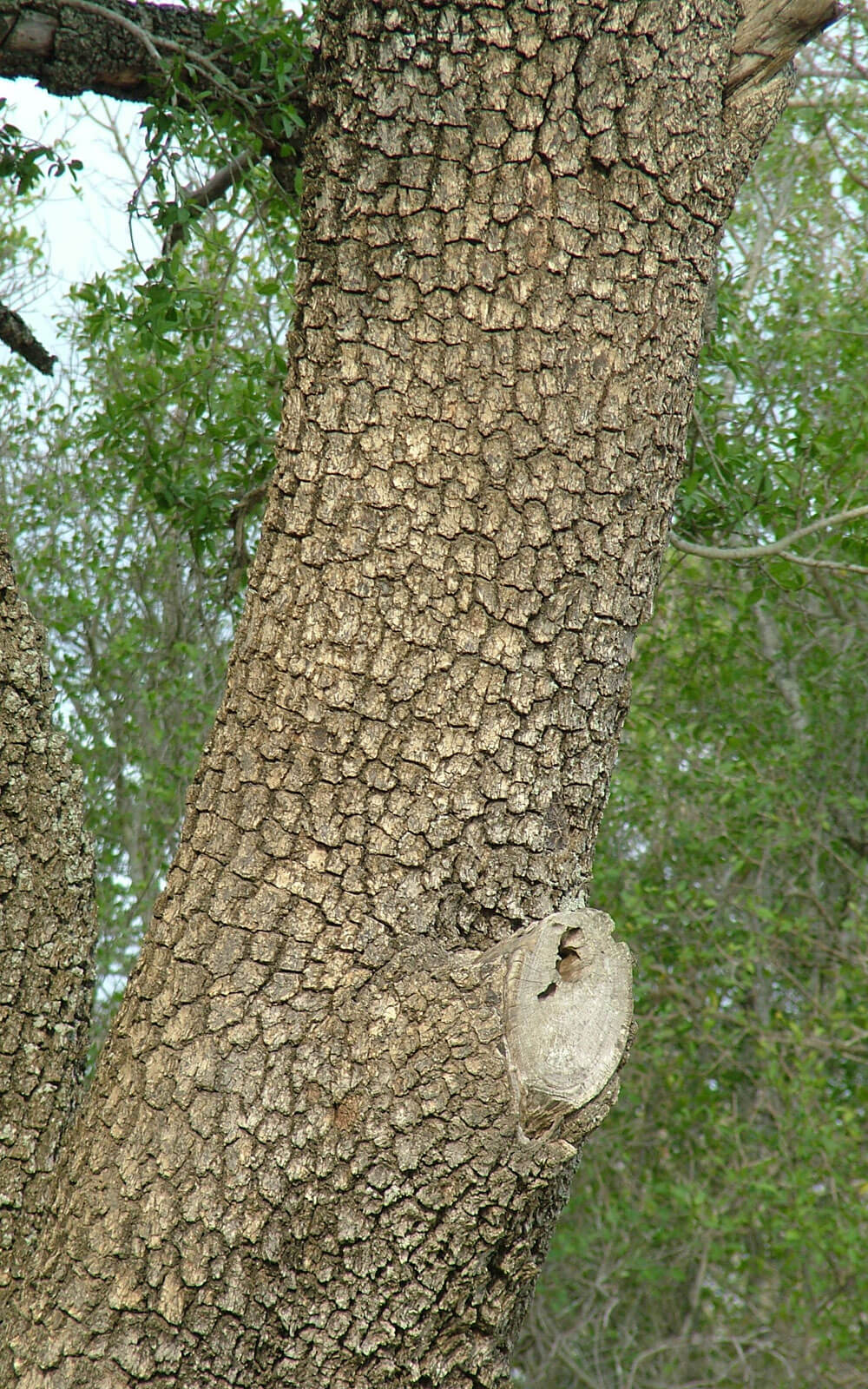
Tamboti trees are easy to recognise in bushveld by the rough, dark bark with irregular cracks—here at Hhluhluwe-Imfolozi Park.
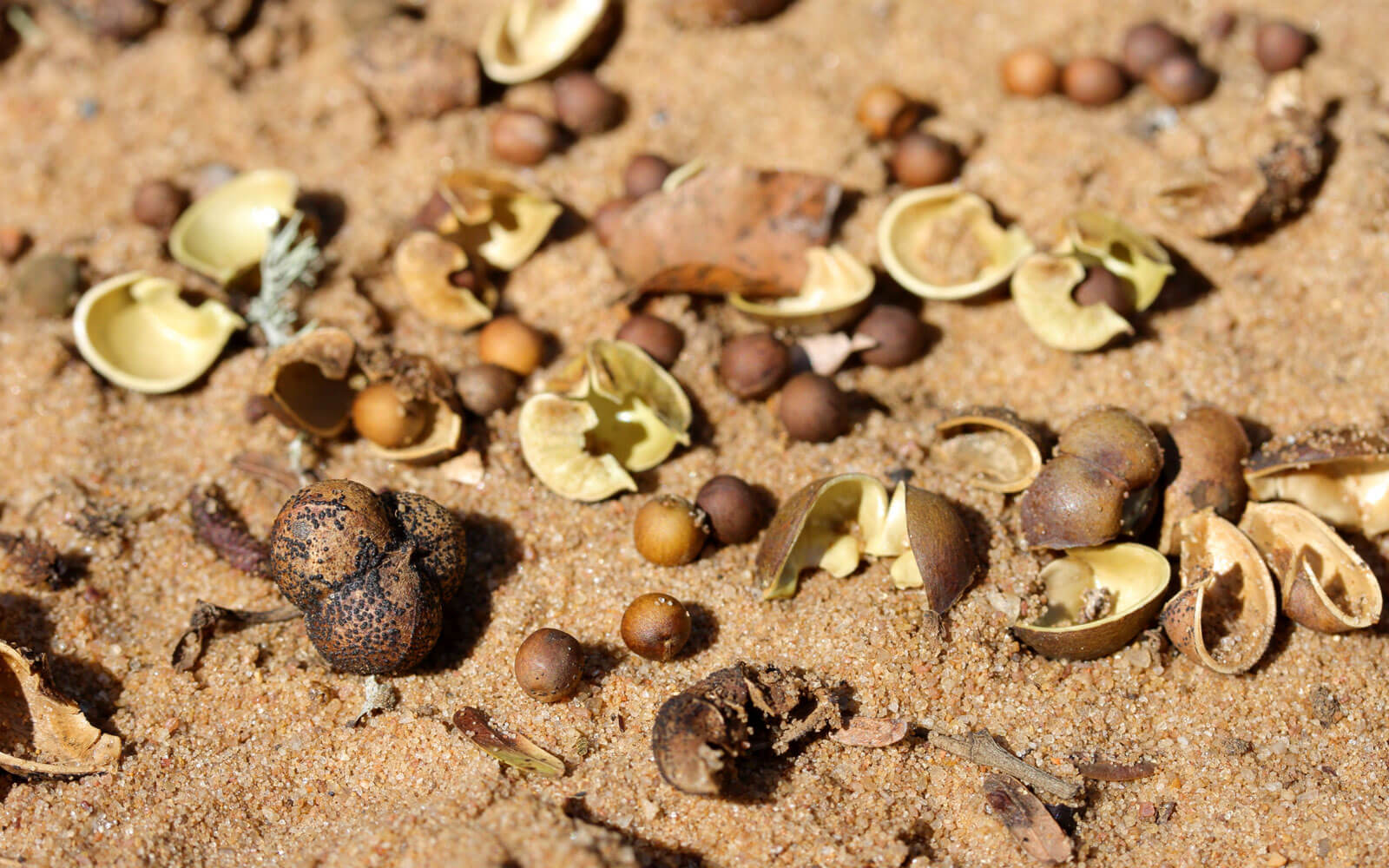
Fallen seed and dehiscing, three-lobed capsules at Bonamanzi Game Reserve.
All plant parts of the Tamboti should be handled with extreme care and never eaten. The milky sap has been used as a fish and arrow poison and can irritate skin and cause blindness, as can sawdust. Smoke from burning logs is poisonous and Tamboti wood should be avoided, especially when cooking food. Given its highly toxic qualities, it is remarkable that elephants and black rhino can eat fresh growth and other wildlife feeds on the fallen leaves in winter. Porcupines may eat the bark from the base of trees. The seeds are eaten by birds once the capsules have exploded and ejected them.
The beautiful wood has a natural sheen and an agreeable sweet, spicy odour. The tree is sometimes called ‘African Sandalwood’. The heartwood is dark brown, fine-textured, very hard and durable and has a flame-like surface pattern. The sapwood is pale yellow and less durable. The combination of dark and pale wood is striking. Tamboti wood has been used for furniture, hut building and fence poles, and pieces are used as an insect repellent or to make scented necklaces.
Roots, bark and sap are used medicinally, e.g. as a purgative and to cure toothache, possibly by destroying raw nerves.
Capsules may be infested by the larvae of the Jumping Bean Moth Emporia melanobasis. When that happens, on warm days when the fruit is dry, the larvae flex inside and cause the capsule to jump up a few centimetres off the ground. Tambotis are sometimes referred to as ‘jumping-bean trees’.
New plants can be grown from seed or cuttings. Seed should be collected from the tree when ripe because seed taken from the ground is often parasitised. Sow seed shallowly in a sandy mix. Trees can be slow- or quick-growing, depending on growing conditions. They are fairly drought and frost resistant and make good bonsais. They look good in small groups and, in Durban, will probably do best in a sunny, well-drained spot.
Acknowledgements
Thank you to Prof. Adrian Koopman for the derivations of the Zulu names and to Steve Woodhall for providing the photograph of Boisduval’s False Acraea.
References
Boon, R. [R.G.C.] (2010) Pooley’s trees of eastern South Africa. A complete guide. Flora and Fauna Publications Trust, Durban, 626 pp.
Dyer, S., James, B. & James, D. (2016) Guide to the properties of southern African wood. Briza Publications, Pretoria, South Africa.
Esterhuyse, N., Von Breitenbach, J. & Söhnge, H. (2001) Remarkable trees of South Africa. Briza Publications, Pretoria, South Africa.
Glen, H. (2004) Sappi what’s in a name. The meanings of the botanical names of trees. Jacana Media (Pty) Ltd, Johannesburg, 80 pp.
iNaturalist available at https://www.inaturalist.org/home
PlantZAhttps://pza.sanbi.org/mimusops-caffra, PlantZAhttps://pza.sanbi.org/sideroxylon-inerme, PlantZAhttps://pza.sanbi.org/spirostachys-africana
Plants of the World Online (POWO) available at https://powo.science.kew.org/
Van Wyk, B-E. & Gericke, G. (2000) People’s plants. A guide to useful plants of southern Africa. Briza Publications, Pretoria, South Africa.
Van Wyk, B. & Van Wyk, P. (2013) Field guide to the trees of southern Africa, 2nd edn fully revised. Struik Nature, Cape Town, 732 pp.
Wikipedia. Wikimedia Foundation. Various articles accessed during May 2025.
Woodhall, S. (2005) Field guide to the butterflies of South Africa. Struik Publishers, Cape Town, 440 pp.
Botanical name changes
https://www.nature.com/articles/d44148-024-00296-3
https://www.smithsonianmag.com/smart-news/botanists-vote-to-remove-racial-slur-from-hundreds-of-plant-species-names-180984762/
https://www.linnean.org/news/2024/07/23/international-botanists-vote-to-change-offensive-plant-name
https://www.theguardian.com/commentisfree/2022/oct/01/slave-traders-names-are-still-stamped-on-native-plants-its-time-to-decolonise-australias-public-gardens
South Africa’s protected trees
https://www.gov.za/sites/default/files/gcis_document/202103/44204gon155.pdf
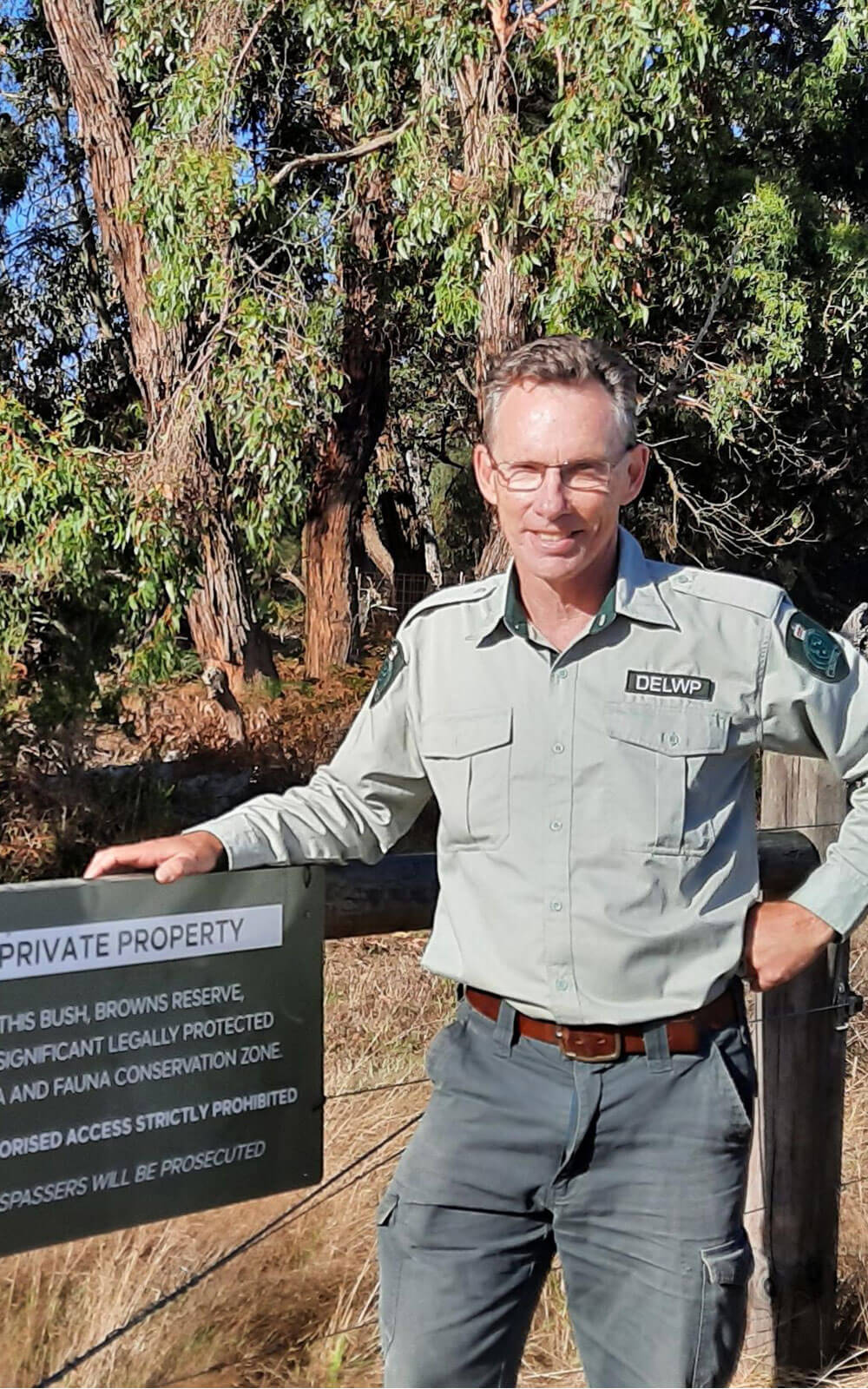
About the author
Richard Boon is well-known not only for his outstanding book Trees of Eastern South Africa – A Complete Guide but also for his environmental work at WESSA in the 90’s and later as part of the Environmental Planning and Climate Protection Department at eThekwini where he headed up the Biodiversity Planning Branch until end 2018. Richard is a practical botanist with over 25 years of field experience. He also enjoys photographing plants and other natural subjects. This article was written for The Leopard’s Echo from his new home in Melbourne, Australia. He currently works for the Victorian state government on native vegetation offset management. The role includes travelling statewide to visit new places and meet landowners. Work involves lots of learning and is much more field-based which has been a nice change. In his spare time, he learns the local ecology, flora and fauna.